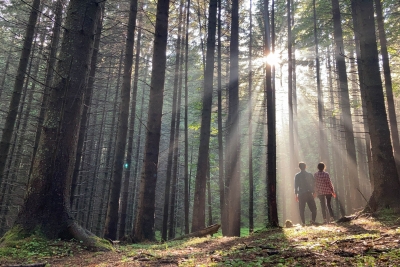Nature has many sustainable solutions to numerous pressing problems that man is struggling to cope with today. Scientists and engineers study these unique models and systems of nature while designing new technologies. This biologically-inspired engineering, called biomimicry, biomimetics or bionics, is fast gaining popularity in many parts of the world.
American biologist Janine M. Benyus, who wrote the book. Biomimicry Innovation Inspired by Nature was the first to propose that learning from nature would be the perfect tool for eco-design
The leaf of the lotus plant has a way surface that is covered with tiny bumps or ridges. These ridges cause water droplets to roll off carrying away dust and dirt. This unique ability of the plant to clean itself called the Lotus Effect, was the inspiration behind self-cleaning paint coatings
Besides paints, roof tiles and optical sensors in public places like toll bridges also use innovations based on the Lotus Effect Research is also underway to create self-cleaning textiles. plastic and metals.
Inspired by insects
The Eastgate Centre, an office complex in Harare. Zimbabwe, has been designed to mimic the mounds of the African tower building termites (Macrotermes Michaelseni) which use a unique system to keep their homes cool. The insects have developed a method which involves opening and closing air vents in the mound in such a way that cool air is drawn inside while hot air escapes through the chimney. The Eastgate Centre uses 10 per cent less energy than conventional structures of the same size. by adopting the design and ventilation system of the termites.
Sportswear manufacturer Speedo’s swimsuit. the Fastskin LZR Racer, has been fashioned from fabric that mimics the shape and rough texture of sharkskin. This ‘sharkskin’ swimsuit reduces drag, enabling competitive swimmers to shave a few crucial seconds off their race timings. This technology is also being used to develop coatings for ship hulls, submarines and aircraft fuselage.
The tropical boxfish, a reef-dwelling amphibian, inspired Daimler Chryslers concept car. The Bionic Car, as the automobile is called, mimics the fish’s aerodynamic shape and the structure of its rigid protective skin. This innovation consumes 20 per cent less fuel and emits 80 per cent less nitrogen oxide than conventional automobiles. Researchers at the University of California have created two prototype glues after studying the way geckos move across ceilings and cling to polished glass. The soles of Tokay geckos have sticky ridges which contain half a million microscopic hairs. These tiny hairs which exert an attractive force on the wall or floor are responsible for the lizard’s superb grip. The stickiness of gecko adhesive never wears off. The scientists cast two sets of imitation gecko toe hairs and then tipped the hairs with silicon rubber or polyester. In the lab, both materials adhered as well to most surfaces as gecko’s feet.
Fire-extinguisher
Scientists at the Leeds University in England have built an experimental contraption that can shoot a spray of chemicals up to a distance of four metres. The device mimics the behaviour of the bombardier beetle, which squirts a hot explosive stream of venom to ward off predators. The chemical concoction is mixed in a sort of ‘combustion chamber in the insect’s abdomen, with inlet and exit valves determining the precise blend.
Researchers are utilising this technology to build pharmaceutical inhalers and long-range fire extinguishers.
Bullet train
The world’s fastest train, the Japanese shinkansen bullet train includes a number of biomimetic innovations. The trains, which zip between cities at a speed of close to 321 km per hour, have serrations similar to those that allow owls to fly stealthily through the night. This feature is incorporated in the overhead wire collectors to reduce noise. The train’s nose, which mimics the aerodynamic beak of the kingfisher, enables the train to exit tunnels without emitting sonic booms.
Velcro plants
It was only recently that man discovered the touch and close tape. Velcro. This discovery was inspired by nature, since seeds, fruits and even whole plants stowaway on the coats of animals by gripping on in the same manner as Velcro: and have been doing so since time immemorial.
It was in the 1950s that George de Mestral of Switzerland observed the burdock fruit which led him to develop Velcro. This fruit has barbed hooks that enable it to fasten itself to an animal’s fur. And when the burr is brushed off the coat of the animal the casing splits open. The seeds of the burdock are thus spread over a wide area and do not have to germinate in one place
Stowaways like the burdock can be counted in the hundreds in the plant world
Froggy tape
Researchers at the Indian Institute of Technology (IT) Kanpur, who were working on creating a reusable sticky tape, received inspiration from an unusual source- the humble tree frog.
It was observed that the sticky toe pads of tree frogs have a patter of tiny channels that increase their adhesion to a surface and prevent the spread of cracks when the frog moves away.
Based on this study, scientists designed a novel sticky tape by placing elastic layers embedded with air or fluid-filled micro channels beneath the authesive layer. This new reusable tape is 30 times stickier than other adhesive tapes.
Picture Credit: Google





